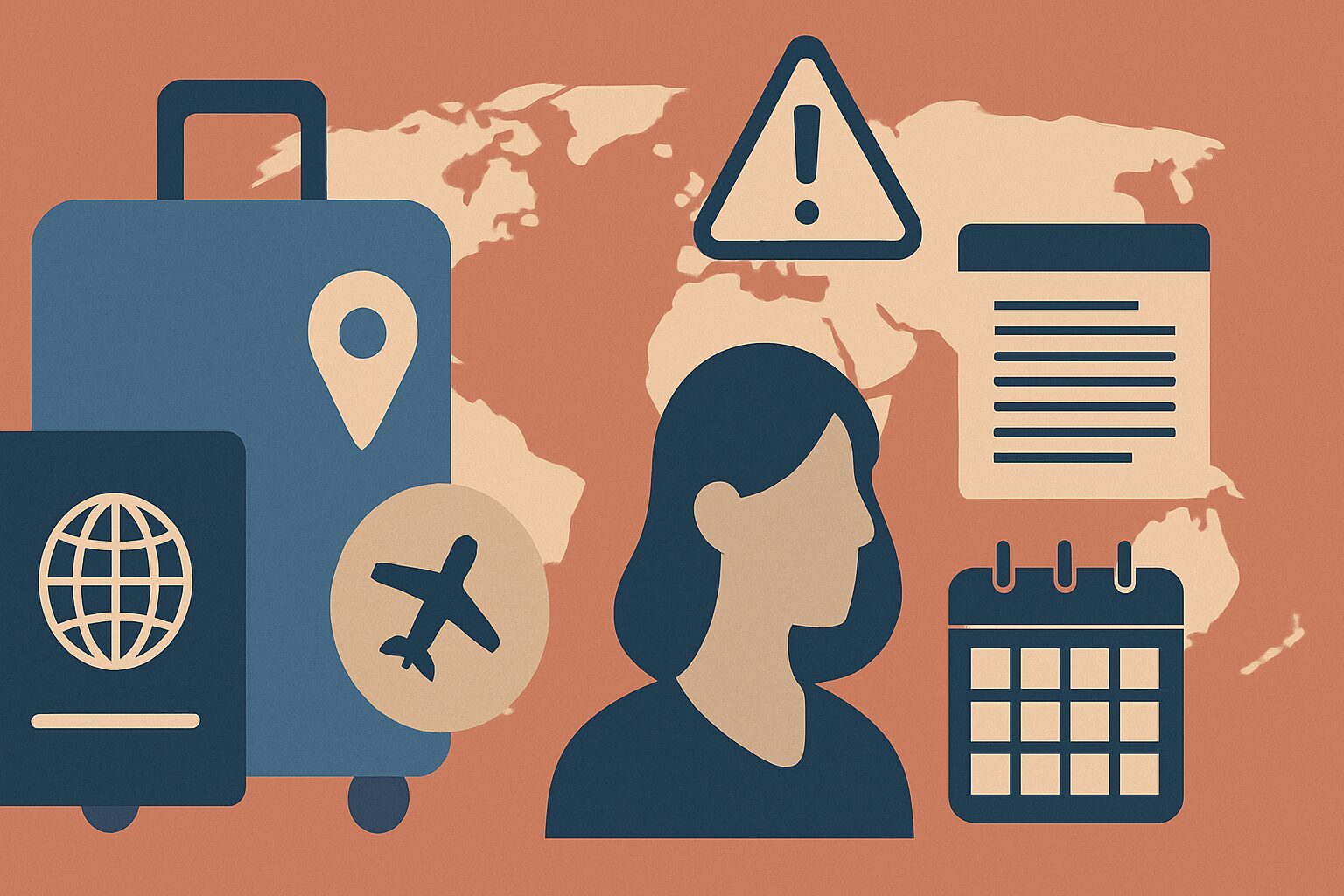Recently, the U.S. State Department raised the travel warning levels for 21 countries, advising Americans to avoid these destinations. This update is crucial for travelers planning international trips. Here’s what you need to know about the implications of these warnings and how to stay safe while traveling.
Key Takeaways
- The U.S. has issued a ‘Do Not Travel’ alert for 21 countries due to serious safety concerns.
- Travel advisories are updated regularly based on factors like health risks, civil unrest, and crime rates.
- Level 4 advisories indicate a high likelihood of life-threatening risks for travelers.
- It’s essential to stay informed through the State Department’s updates and local authorities.
- Consider travel insurance and emergency contacts if you must travel to high-risk areas.
Overview Of The Travel Advisory Update
Recent Changes In Travel Warnings
So, the U.S. State Department just dropped its latest round of travel advisories, and it’s a mixed bag. They’re always updating these things based on what’s happening around the world, from crime spikes to health scares. It’s worth keeping an eye on, especially if you’ve got any trips planned. The travel advisory levels range from a simple “exercise normal precautions” to a flat-out “do not travel.” They don’t just change the levels, either; sometimes they’ll update the details even if the level stays the same, so it pays to check back regularly.
Countries Affected By The Update
There’s a whole bunch of countries on the list this time around. Some popular spots, like The Bahamas, got a Level 2, meaning “exercise increased caution.” Then you’ve got places with Level 4 advisories – the “do not travel” zones – like Yemen and Syria. Mexico is interesting because different states have different levels, so you really need to drill down if you’re heading there. Here’s a quick rundown of some of the countries and their advisory levels as of today, April 30, 2025:
- Level 1 (Exercise Normal Precautions): Canada, Australia, Portugal
- Level 2 (Exercise Increased Caution): The Bahamas, Kenya, Turks and Caicos Islands
- Level 3 (Reconsider Travel): Pakistan, Chad, Guinea-Bissau
- Level 4 (Do Not Travel): Yemen, Iran, Syria
Implications For Travelers
What does all this mean for you? Well, if you’re planning a trip, these advisories should definitely be on your radar. A Level 1 advisory is no big deal, but anything higher means you need to do your homework. Check the specific risks the State Department is flagging, think about your comfort level, and make sure you’ve got a plan B. Travel insurance is a must, and it’s always a good idea to let someone know your itinerary and keep in touch while you’re away. Basically, don’t just wing it – be smart and be prepared.
Understanding The ‘Do Not Travel’ Alert
Definition Of Level 4 Advisory
So, what does it actually mean when the State Department slaps a “Do Not Travel” advisory on a country? Well, it’s pretty serious. A Level 4 advisory is the highest warning they can issue. It basically says, “Hey, things are super risky here, and you probably shouldn’t go.” It’s not just a suggestion; it’s a strong recommendation to avoid all travel to that destination. Think of it as the government’s way of saying, “We can’t guarantee your safety if you go there.”
Reasons For Issuing A ‘Do Not Travel’ Alert
Why does a country get slapped with a Level 4 advisory? There are a bunch of reasons, and it’s usually a combination of factors. We’re talking serious stuff like:
- Widespread violence or conflict: Think war zones or areas with ongoing political instability.
- High risk of terrorism: Places where terrorist groups are active and attacks are likely.
- Out-of-control crime: Countries with high rates of violent crime, like kidnapping or armed robbery, where the local police can’t really do much.
- Serious health risks: Major disease outbreaks or a complete lack of adequate medical care.
- Wrongful detention: A significant risk of being arbitrarily arrested and detained by the government.
Basically, if a country is facing any of these issues to a degree that makes it too dangerous for tourists, it’s likely to get a Level 4.
Potential Risks Associated With Travel
Okay, so you ignore the “Do Not Travel” advisory. What could really happen? Well, a lot. The risks are very real and can be life-threatening. Here’s a taste:
- Physical harm: You could be caught in the crossfire of a conflict, become a victim of violent crime, or be injured in a terrorist attack.
- Kidnapping: This is a serious risk in some Level 4 countries, where foreigners are specifically targeted.
- Lack of medical care: If you get sick or injured, you might not be able to get the treatment you need, which could have serious consequences. Make sure you understand the Real ID requirements before you travel.
- Arbitrary arrest or detention: You could be arrested for something that’s not even a crime in your home country, and you might not have access to legal representation.
- Inability to leave: In extreme cases, you might not be able to leave the country due to airport closures or other travel restrictions.
It’s really not worth the risk. The State Department issues these advisories for a reason – to protect American citizens.
Countries Under ‘Do Not Travel’ Alert
List Of 21 Countries
As of today, April 30, 2025, the U.S. State Department has issued a Level 4 “Do Not Travel” advisory for 21 countries. This designation indicates a high level of risk for travelers, and citizens are strongly advised to avoid travel to these destinations. The reasons behind these advisories vary, ranging from armed conflict and widespread crime to health crises and political instability. It’s important to note that this list is subject to change as conditions evolve, and the State Department regularly updates its advisories.
Specific Risks In Each Country
The specific risks that contribute to a “Do Not Travel” advisory differ from country to country. For example, in Yemen, Iran, South Sudan and Syria, the primary concern is ongoing armed conflict and the high risk of terrorism and kidnapping. Other countries may face high levels of violent crime, civil unrest, or health emergencies that pose a significant threat to travelers. It’s essential to check the specific advisory for each country to understand the nature of the risks involved. The State Department updated a series of travel advisories last month, so it’s worth checking regularly.
Travel Recommendations For Affected Regions
For regions under a “Do Not Travel” advisory, the strongest recommendation is, unsurprisingly, to avoid all travel to those areas. If you are a U.S. citizen currently in one of these countries, the State Department advises you to depart as soon as it is safe to do so. Here are some general recommendations:
- Enroll in the Smart Traveler Enrollment Program (STEP): This allows the State Department to locate you in case of an emergency.
- Monitor local news and information: Stay informed about current events and potential safety risks.
- Have an evacuation plan: Know how you will leave the country if the situation deteriorates.
- Inform family and friends: Keep them updated on your situation and travel plans.
It’s also a good idea to reconsider travel to countries with a Level 3 advisory. For example, Guinea-Bissau, Trinidad and Tobago, Niger, Chad and Pakistan are all at Level 3. You can find more information about planning a summer vacation on the State Department’s website.
Factors Influencing Travel Advisory Levels
Health Risks And Safety Concerns
Health risks and safety concerns are big factors when the State Department decides on a travel advisory level. This includes things like disease outbreaks, the quality of healthcare available, and the risk of getting sick from food or water. For example, a country experiencing a widespread outbreak of a serious illness might get a higher advisory level. Also, areas with poor sanitation or limited access to medical care can be considered riskier.
Civil Unrest And Crime Rates
Civil unrest and crime rates play a significant role in travel advisories. If a country is experiencing political instability, protests, or violent demonstrations, the advisory level will likely go up. High crime rates, especially violent crime, also contribute to a higher advisory level. The State Department looks at how common crime is, what kind of crime it is, and how likely tourists are to be affected. For example, a country with frequent kidnappings or terrorist attacks would probably get a “Do Not Travel” warning.
Natural Disasters And Other Events
Natural disasters and other unexpected events can also influence travel advisory levels. This includes things like earthquakes, hurricanes, floods, and volcanic eruptions. The State Department considers how likely these events are to happen, how severe they might be, and how well the country is prepared to deal with them. Other events, like political coups or sudden changes in government, can also affect the advisory level. Basically, anything that could put travelers at risk is taken into account.
How To Stay Informed About Travel Advisories
Monitoring State Department Updates
The U.S. State Department is the go-to source for travel advisories. They update these advisories regularly, so checking their website should be a routine part of your travel planning. They review Level 1 and 2 advisories at least every 12 months, and Level 3 and 4 advisories at least every six months. Plus, they update advisories whenever there’s a change in the U.S. government’s stance, especially concerning security issues. You can find the advisories in a searchable list and on a map on their website.
Using Travel Apps And Resources
Beyond the State Department, a bunch of travel apps and websites compile travel safety info. These can be super handy for getting real-time updates and different perspectives. Some things to consider:
- Check multiple sources: Don’t rely on just one app or website.
- Read reviews: See what other travelers are saying about safety in your destination.
- Look for up-to-date info: Make sure the app or website is actively maintained.
Consulting Local Authorities Before Travel
Before you head out, it’s a good idea to touch base with local authorities or the U.S. embassy in your destination. They can give you the most current info on the ground. Here’s why it’s important:
- They know the local situation best.
- They can provide specific safety tips.
- They can help in case of an emergency.
Travel Tips For High-Risk Areas
Preparing For Potential Risks
Okay, so you’re thinking about heading somewhere with a higher travel advisory. First things first: preparation is key. Before you even book that flight, do a ton of research. I mean, really dig in. Understand the specific risks in the regions you plan to visit. This isn’t just about reading the State Department’s advisory (though that’s a must-do). Look for local news sources, travel blogs, and forums where people share their experiences.
- Make copies of all your important documents (passport, visa, driver’s license) and store them separately from the originals. Consider keeping digital copies in a secure, cloud-based storage.
- Share your itinerary with family or friends back home, and check in with them regularly.
- Learn a few basic phrases in the local language. It can be a lifesaver in an emergency.
Emergency Contacts And Resources
Having the right contacts can make a huge difference if things go south. Program these into your phone and have them written down, too, just in case.
- The U.S. embassy or consulate in the country you’re visiting.
- Local emergency services (police, fire, ambulance).
- Your travel insurance provider’s emergency assistance hotline.
- A trusted contact back home who can help coordinate things if needed.
Travel Insurance Considerations
Don’t even think about skipping travel insurance, especially for high-risk areas. But not all policies are created equal. You need to read the fine print and make sure it covers the specific risks you might face.
- Check if the policy covers medical evacuation. This can be incredibly expensive, so you want to be sure you’re covered.
- See if it includes coverage for trip cancellation or interruption due to unforeseen events.
- Understand the policy’s exclusions. Some policies won’t cover incidents that occur in countries with a Level 4 travel advisory, so be careful.
Impact Of Travel Warnings On Tourism
Effects On Travel Industry
Travel warnings can really mess with the travel industry. When the State Department slaps a “Do Not Travel” advisory on a country, airlines might cut routes, hotels could see massive cancellations, and tour operators might have to shut down completely. The immediate effect is often a sharp drop in bookings and revenue for businesses that rely on tourism. For example, after the recent advisory updates, Tourism Economics predicts international travel to the U.S. will fall by 15.2% in 2025, potentially costing the industry $90 billion. It’s a domino effect that can hit local economies hard.
Traveler Sentiment And Behavior
Travel advisories definitely influence where people choose to go. Nobody wants to vacation in a place where their safety is at risk. News stories about detained travelers or civil unrest can scare people away, even if the actual risk is low. People might opt for safer, more stable destinations, leading to a shift in tourism patterns. Some travelers might decide to postpone or cancel their trips altogether. It’s all about perceived risk, and travel warnings amplify those fears.
Long-Term Implications For Affected Countries
For countries hit with long-term travel warnings, the effects can be devastating. Tourism is a major source of income for many places, and a sustained drop in visitor numbers can lead to job losses, business closures, and economic hardship. It can also damage a country’s reputation, making it harder to attract investment and rebuild its tourism sector in the future. The impact isn’t just economic; it can affect the social and cultural fabric of a place, too. It’s a tough situation to recover from.
Final Thoughts on Travel Warnings
As you plan your next trip, keep these travel warnings in mind. The U.S. State Department has raised alerts for 21 countries, and it’s important to know what that means for your safety. If you’re thinking about visiting any of these places, take the time to research the current situation. Stay informed about risks like crime or health issues. And if you decide to go, make sure you have a solid plan in place. Travel can be an amazing experience, but safety should always come first.
Frequently Asked Questions
What does a ‘Do Not Travel’ warning mean?
A ‘Do Not Travel’ warning means that the U.S. government advises against traveling to that country due to serious risks.
How many countries currently have a Level 4 warning?
As of now, there are 21 countries with a Level 4 warning from the U.S. State Department.
What factors lead to a travel advisory update?
Travel advisories can change due to health risks, crime, civil unrest, or natural disasters.
How can travelers stay updated on travel warnings?
Travelers can check the U.S. State Department’s website and use travel apps for the latest updates.
What should I do if I need to travel to a high-risk country?
If you must travel to a high-risk area, make sure to prepare by understanding the risks and having emergency contacts ready.
How do travel warnings affect tourism in those countries?
Travel warnings can greatly impact tourism by discouraging visitors, which can hurt the local economy.




